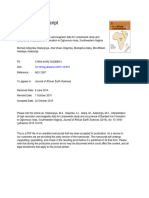ENGR1330-Assignment5
Uploaded by
ja1001000100ENGR1330-Assignment5
Uploaded by
ja1001000100Assignment-5 (100 points)
Anthony, James
R#11937991
# RUN this cell and do not modify it
import sys
! hostname
! whoami
print(sys.executable)
print(sys.version)
print(sys.version_info)
DESKTOP-LKKK32J
desktop-lkkk32j\ja606
C:\Users\ja606\anaconda3\python.exe
3.12.4 | packaged by Anaconda, Inc. | (main, Jun 18 2024, 15:03:56) [MSC v.1929 64 bit (AMD64)]
sys.version_info(major=3, minor=12, micro=4, releaselevel='final', serial=0)
Question 1 (20 pts): NumPy Playground
The core datatype of NumPy is the NumPy Array. NumPy Arrays build on the basic Python List
datatype to add functionality for vector math and common statistical calculations. The easiest
way to create a NumPy Array is to first create a List and then passing it as the argument to the
np.Array() constructor. In this exercise, you'll create some NumPy arrays, and then perform
some simple operations on them.
Resources
https://www.w3schools.com/PYTHON/numpy/numpy_creating_arrays.asp
https://www.w3schools.com/PYTHON/numpy/numpy_array_shape.asp
https://www.w3schools.com/PYTHON/numpy/numpy_array_sort.asp
Instructions
1. Create a 1-dimensional Array, named my_arr containing the elements [9,8,7,6,5,4,3,2,1].
2. Print the shape of my_arr.
3. Create a 2-dimensional Array, named my_mat containing rows, each containing a copy of my_arr.
4. Print the shape of my_mat.
5. Create a new Array named my_prod and use it to store the result of the operation my_arr * my_arr.
6. Print out my_prod
7. Use the np.sort function to sort my_prod and store the result in a new Array named my_prod_sorted.
8. Print out my_prod_sorted
# Question 1 Code Goes Here
import numpy as np
my_arr = np.array([9, 8, 7, 6, 5, 4, 3, 2, 1])
print("Shape of my_arr:", my_arr.shape)
my_mat = np.tile(my_arr, (3, 1))
print("Shape of my_mat:", my_mat.shape)
my_prod = my_arr * my_arr
print("my_prod:", my_prod)
my_prod_sorted = np.sort(my_prod)
print("my_prod_sorted:", my_prod_sorted)
Shape of my_arr: (9,)
Shape of my_mat: (3, 9)
my_prod: [81 64 49 36 25 16 9 4 1]
my_prod_sorted: [ 1 4 9 16 25 36 49 64 81]
Question 2 (20 pts) Matrices:
NumPy really shines when it's time to work with vectors and matrices. A lot of complex
operations work right out of the box and are very easy to use. In this exercise, we'll look at how
to manipulate the shape of matrices, access their rows and columns, and perform some matrix
math operation
https://www.w3schools.com/PYTHON/numpy/numpy_array_reshape.asp
https://www.w3schools.com/PYTHON/numpy/numpy_array_indexing.asp
https://pythonexamples.org/python-numpy-dot-product/
1. In Question 2, you created an array called my_arr. Use the reshape function to create a 3x3 matrix named arr_reshaped.
2. Print out arr_reshaped to see the result.
3. Use indexing to print out the last row of the matrix and print out the element at the center of the matrix.
4. Create two 1-dimensional arrays named X and Y with the elements [3,9,5,4] and [1,8,7,6], respectively.
5. Compute the dot product of X and Y and print the result.
import numpy as np
my_arr = np.array([9, 8, 7, 6, 5, 4, 3, 2, 1])
arr_reshaped = my_arr.reshape(3, 3)
print("arr_reshaped:\n", arr_reshaped)
last_row = arr_reshaped[-1]
print("Last row:", last_row)
center_element = arr_reshaped[1, 1]
print("Element at the center:", center_element)
X = np.array([3, 9, 5, 4])
Y = np.array([1, 8, 7, 6])
dot_product = np.dot(X, Y)
print("Dot product of X and Y:", dot_product)
arr_reshaped:
[[9 8 7]
[6 5 4]
[3 2 1]]
Last row: [3 2 1]
Element at the center: 5
Dot product of X and Y: 134
Question 3 (20 pts):
Find the root of the function y(x) = x 3 − 2x − 5x using the bisection method and the secant method. Plot the function and the
approximations from both methods.
# Question 3 Code Bisection Goes Here
import numpy as np
def f(x):
return x**3 - 7*x
def bisection(a, b, tol=1e-6, max_iter=100):
iter_count = 0
while (b - a) / 2 > tol:
c = (a + b) / 2
if f(c) == 0:
return c
elif f(a) * f(c) < 0:
b = c
else:
a = c
iter_count += 1
if iter_count > max_iter:
break
return (a + b) / 2
a, b = -3, 3
root_bisection = bisection(a, b)
print(f"Root from Bisection Method: {root_bisection}")
Root from Bisection Method: 0.0
# Question 3 Code Secant Goes Here
import numpy as np
def f(x):
return x**3 - 7*x
def secant(x0, x1, tol=1e-6, max_iter=100):
iter_count = 0
while abs(x1 - x0) > tol:
x_new = x1 - f(x1) * (x1 - x0) / (f(x1) - f(x0))
x0, x1 = x1, x_new
iter_count += 1
if iter_count > max_iter:
break
return x1
x0, x1 = -3, 3
root_secant = secant(x0, x1)
print(f"Root from Secant Method: {root_secant}")
Root from Secant Method: 0.0
Question 4 (20 pts):
You will simulate heat conduction along a metal rod using the finite difference method. The goal is to observe how the temperature
evolves over time.
Given:
Length of the rod (L): 1 meter
Initial temperature distribution: Uniform at 100°C
Boundary conditions:
(u(0, t) = 100) °C (left end)
(u(L, t) = 0) °C (right end)
Total simulation time (T): 1 second
Spatial step ( Delta x): 0.1 m
Time step ( Delta t): 0.01 s
Thermal diffusivity (alpha): 0.1 m²/s
Tasks
1. Initialize the temperature distribution along the rod.
2. Use the explicit finite difference method to update the temperature at each time step.
3. Apply the boundary conditions at each time step.
4. Visualize the temperature distribution at selected time intervals.
Use the below example code as an outline for your code
# EXAMPLE CODE STRUCTURE- USe it to write yor own below
import numpy as np
import matplotlib.pyplot as plt
# Parameters
L = 1.0 # Length of the rod
alpha = 0.1 # Thermal diffusivity
T = 1.0 # Total time
dx = 0.1 # Spatial step
dt = 0.01 # Time step
# Discretization
x = np.arange(0, L + dx, dx)
Nx = len(x)
time_steps = int(T / dt)
# Initial condition
u = np.ones(Nx) * 100 # Initial temperature: 100°C
# Finite difference method
for n in range(time_steps):
u_new = np.copy(u)
for i in range(1, Nx - 1):
u_new[i] = u[i] + alpha * dt / dx**2 * (u[i-1] - 2*u[i] + u[i+1])
# Apply boundary conditions
u_new[0] = 100 # Left end
u_new[-1] = 0 # Right end
u = u_new
# Visualization (plot every 10 steps)
if n % 10 == 0:
plt.plot(x, u, label=f'Time = {n*dt:.2f}s')
# Final plot settings
plt.title('Temperature Distribution along the Rod')
plt.xlabel('Position along the rod (m)')
plt.ylabel('Temperature (°C)')
plt.legend()
plt.grid()
plt.show()
Processing math: 100%
You might also like
- Teddy Mukadzambo R201998U Python RefresherNo ratings yetTeddy Mukadzambo R201998U Python Refresher8 pages
- Exercise: Introduction To Numpy Arrays: Aim: Introduce Basic Numpy Array Creation and IndexingNo ratings yetExercise: Introduction To Numpy Arrays: Aim: Introduce Basic Numpy Array Creation and Indexing8 pages
- MTC-243 Python Programing Language II Slips Semester IV-1No ratings yetMTC-243 Python Programing Language II Slips Semester IV-1188 pages
- Sns Lab Manuals: 18-Ee-128 Musaib AhmedNo ratings yetSns Lab Manuals: 18-Ee-128 Musaib Ahmed104 pages
- Basic Math: 1.1 Scipy Constants (Scipy - Constants)No ratings yetBasic Math: 1.1 Scipy Constants (Scipy - Constants)32 pages
- Maths Sem 4 Slips Solved by Prem Vijay VajareNo ratings yetMaths Sem 4 Slips Solved by Prem Vijay Vajare304 pages
- Workshop Notes-2 Handling Array with NumPyNo ratings yetWorkshop Notes-2 Handling Array with NumPy13 pages
- Enthought: Introduction To Numerical Computing With NumpyNo ratings yetEnthought: Introduction To Numerical Computing With Numpy39 pages
- Applied Machine Learning For Engineers: Introduction To NumpyNo ratings yetApplied Machine Learning For Engineers: Introduction To Numpy13 pages
- Design of Long Span Concrete Box Girder Bridges: Challenges and SolutionsNo ratings yetDesign of Long Span Concrete Box Girder Bridges: Challenges and Solutions11 pages
- Chapter 4 - Non-Uniform Flow in Open ChannelNo ratings yetChapter 4 - Non-Uniform Flow in Open Channel140 pages
- Commercial Gas Boilers Efficient - Aae Series: For Hydronic Heating SystemsNo ratings yetCommercial Gas Boilers Efficient - Aae Series: For Hydronic Heating Systems4 pages
- Effective Width of Slab Calculation as per IRC:22-2015No ratings yetEffective Width of Slab Calculation as per IRC:22-20152 pages
- K.S.K Academy Sr. Sec. Public School: Digital FileNo ratings yetK.S.K Academy Sr. Sec. Public School: Digital File35 pages
- Download full Understanding Mass Spectra A Basic Approach Second Edition R. Martin Smith(Auth.) ebook all chapters100% (6)Download full Understanding Mass Spectra A Basic Approach Second Edition R. Martin Smith(Auth.) ebook all chapters60 pages
- PHYS 211 13ELECTRICITYCIRCUITand - OHMS LAWNo ratings yetPHYS 211 13ELECTRICITYCIRCUITand - OHMS LAW5 pages
- 32.power System Study-Sc, RC & Dynamic Testing100% (2)32.power System Study-Sc, RC & Dynamic Testing136 pages
- Gujarat Technological University: ContentNo ratings yetGujarat Technological University: Content5 pages
- Seismic Performance of Damped-Outrigger System Incorporating Buckling-Restrained BracesNo ratings yetSeismic Performance of Damped-Outrigger System Incorporating Buckling-Restrained Braces12 pages
- MHT Cet Chemistry Triumph STD 11th and 12th MCQ Hints156155340050% (2)MHT Cet Chemistry Triumph STD 11th and 12th MCQ Hints1561553400326 pages
- Exercise: Introduction To Numpy Arrays: Aim: Introduce Basic Numpy Array Creation and IndexingExercise: Introduction To Numpy Arrays: Aim: Introduce Basic Numpy Array Creation and Indexing
- MTC-243 Python Programing Language II Slips Semester IV-1MTC-243 Python Programing Language II Slips Semester IV-1
- Basic Math: 1.1 Scipy Constants (Scipy - Constants)Basic Math: 1.1 Scipy Constants (Scipy - Constants)
- Enthought: Introduction To Numerical Computing With NumpyEnthought: Introduction To Numerical Computing With Numpy
- Applied Machine Learning For Engineers: Introduction To NumpyApplied Machine Learning For Engineers: Introduction To Numpy
- Design of Long Span Concrete Box Girder Bridges: Challenges and SolutionsDesign of Long Span Concrete Box Girder Bridges: Challenges and Solutions
- Commercial Gas Boilers Efficient - Aae Series: For Hydronic Heating SystemsCommercial Gas Boilers Efficient - Aae Series: For Hydronic Heating Systems
- Effective Width of Slab Calculation as per IRC:22-2015Effective Width of Slab Calculation as per IRC:22-2015
- K.S.K Academy Sr. Sec. Public School: Digital FileK.S.K Academy Sr. Sec. Public School: Digital File
- Download full Understanding Mass Spectra A Basic Approach Second Edition R. Martin Smith(Auth.) ebook all chaptersDownload full Understanding Mass Spectra A Basic Approach Second Edition R. Martin Smith(Auth.) ebook all chapters
- Seismic Performance of Damped-Outrigger System Incorporating Buckling-Restrained BracesSeismic Performance of Damped-Outrigger System Incorporating Buckling-Restrained Braces
- MHT Cet Chemistry Triumph STD 11th and 12th MCQ Hints1561553400MHT Cet Chemistry Triumph STD 11th and 12th MCQ Hints1561553400

























































































